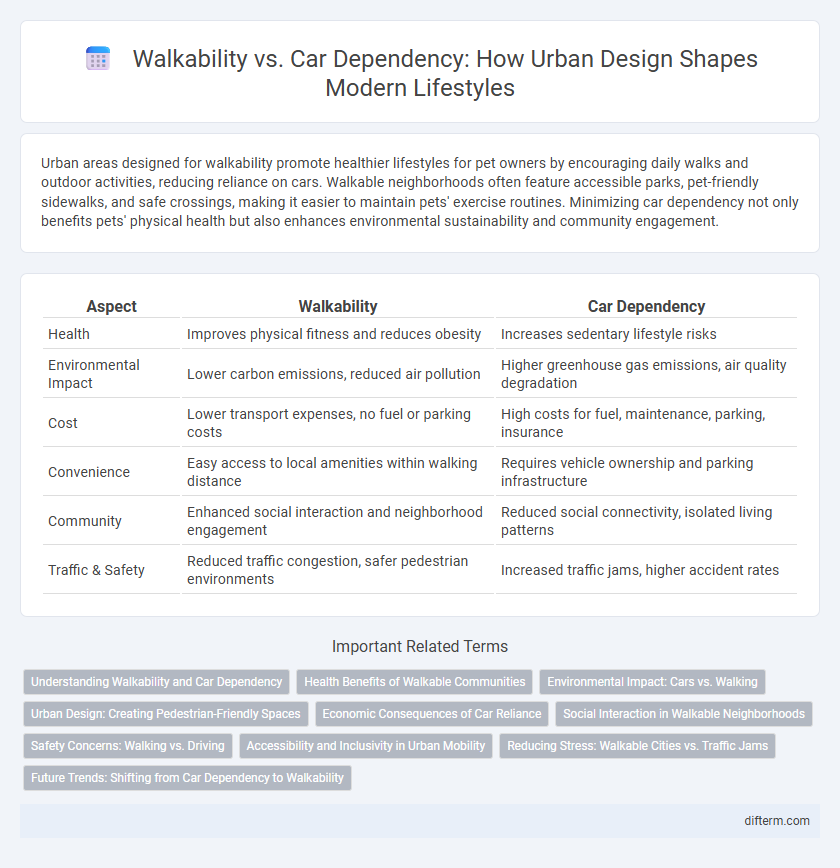Urban areas designed for walkability promote healthier lifestyles for pet owners by encouraging daily walks and outdoor activities, reducing reliance on cars. Walkable neighborhoods often feature accessible parks, pet-friendly sidewalks, and safe crossings, making it easier to maintain pets' exercise routines. Minimizing car dependency not only benefits pets' physical health but also enhances environmental sustainability and community engagement.
Table of Comparison
| Aspect | Walkability | Car Dependency |
|---|---|---|
| Health | Improves physical fitness and reduces obesity | Increases sedentary lifestyle risks |
| Environmental Impact | Lower carbon emissions, reduced air pollution | Higher greenhouse gas emissions, air quality degradation |
| Cost | Lower transport expenses, no fuel or parking costs | High costs for fuel, maintenance, parking, insurance |
| Convenience | Easy access to local amenities within walking distance | Requires vehicle ownership and parking infrastructure |
| Community | Enhanced social interaction and neighborhood engagement | Reduced social connectivity, isolated living patterns |
| Traffic & Safety | Reduced traffic congestion, safer pedestrian environments | Increased traffic jams, higher accident rates |
Understanding Walkability and Car Dependency
Walkability measures how easily residents can access amenities on foot, promoting healthier lifestyles and reducing carbon emissions. Car dependency increases traffic congestion and environmental pollution while limiting physical activity and urban connectivity. Urban planners prioritize walkability to create sustainable, vibrant communities with improved quality of life.
Health Benefits of Walkable Communities
Walkable communities promote higher levels of physical activity by encouraging walking, which significantly reduces risks of obesity, cardiovascular disease, and diabetes. Access to pedestrian-friendly infrastructure increases daily exercise opportunities, contributing to improved mental health and lower stress levels. Reduced car dependency also decreases air pollution, resulting in cleaner environments and better respiratory health for residents.
Environmental Impact: Cars vs. Walking
Walkability significantly reduces carbon emissions by lowering reliance on fossil fuels compared to car dependency, which is a major contributor to air pollution and greenhouse gases. Urban areas designed for walkability promote healthier ecosystems by decreasing noise pollution and preserving green spaces often lost to road infrastructure. Studies show that shifting to pedestrian-friendly environments can cut transportation-related emissions by up to 30%, advancing climate action goals effectively.
Urban Design: Creating Pedestrian-Friendly Spaces
Urban design that prioritizes walkability over car dependency enhances community health and environmental sustainability by integrating mixed-use developments and accessible public transport. Pedestrian-friendly spaces incorporate wide sidewalks, green corridors, and traffic calming measures to ensure safety and encourage foot traffic. These elements collectively reduce carbon emissions and promote active lifestyles in dense urban environments.
Economic Consequences of Car Reliance
Car reliance significantly increases household expenses due to fuel, maintenance, insurance, and parking costs, consuming a larger share of monthly income compared to walkable communities. Reduced walkability also hampers local economic growth by limiting foot traffic for small businesses and increasing public infrastructure spending on roads and parking facilities. Shifting towards walkable urban design can stimulate economic savings and promote sustainable community development.
Social Interaction in Walkable Neighborhoods
Walkable neighborhoods promote social interaction by encouraging residents to walk, meet, and engage with neighbors in public spaces such as parks, cafes, and sidewalks. This increased face-to-face communication strengthens community bonds and fosters a sense of belonging. In contrast, car-dependent areas often isolate individuals, limiting spontaneous social encounters and weakening community ties.
Safety Concerns: Walking vs. Driving
Walkability significantly reduces safety risks compared to car dependency, as pedestrian-friendly environments lower the likelihood of high-speed collisions and traffic fatalities. Streets designed with crosswalks, traffic calming measures, and adequate lighting enhance pedestrian safety, while driving increases exposure to accidents caused by high speeds and distracted driving. Promoting walkable communities not only decreases injury rates but also fosters safer lifestyles through increased foot traffic and vigilance.
Accessibility and Inclusivity in Urban Mobility
Enhanced walkability in urban areas significantly improves accessibility by reducing reliance on cars and promoting inclusive mobility for all age groups and abilities. Prioritizing pedestrian-friendly infrastructure like wide sidewalks, safe crossings, and ramps ensures equitable access to essential services and public spaces. This approach fosters social integration and reduces transportation barriers, advancing overall community well-being and sustainability.
Reducing Stress: Walkable Cities vs. Traffic Jams
Walkable cities significantly reduce stress by offering easy access to amenities through pedestrian-friendly infrastructure, promoting physical activity and mental well-being. In contrast, car dependency often leads to traffic jams that increase cortisol levels, contributing to chronic stress and health issues. Urban designs prioritizing walkability foster a calmer, healthier lifestyle by minimizing commute times and enhancing social interaction.
Future Trends: Shifting from Car Dependency to Walkability
Urban planning is increasingly prioritizing walkability to reduce car dependency, with smart city designs integrating pedestrian-friendly infrastructure, mixed-use developments, and enhanced public transit options. Technologies such as AI-driven traffic management and electric scooter sharing promote sustainable mobility while minimizing carbon footprints. Future lifestyle trends indicate a growing preference for walkable neighborhoods that support health, social interaction, and environmental resilience.
walkability vs car dependency Infographic

 difterm.com
difterm.com